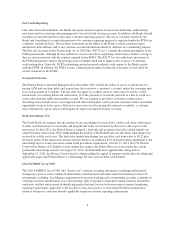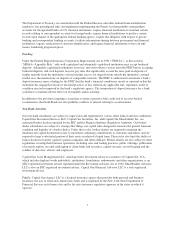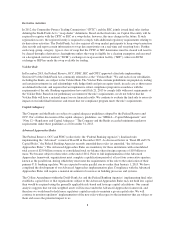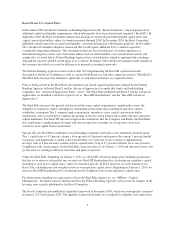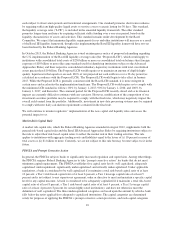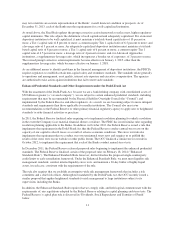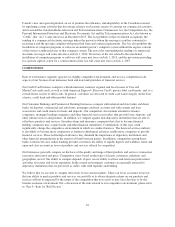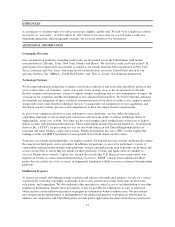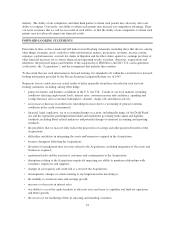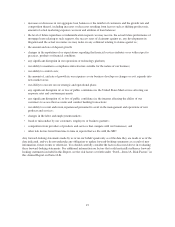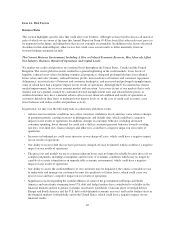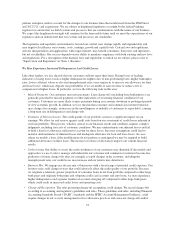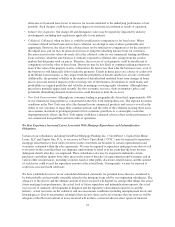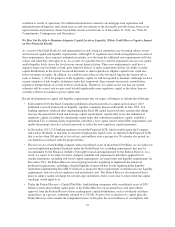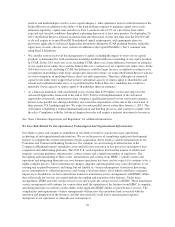Capital One 2013 Annual Report Download - page 36
Download and view the complete annual report
Please find page 36 of the 2013 Capital One annual report below. You can navigate through the pages in the report by either clicking on the pages listed below, or by using the keyword search tool below to find specific information within the annual report.
Canada’s new anti-spam legislation, an act to promote the efficiency and adaptability of the Canadian economy
by regulating certain activities that discourage reliance on electronic means of carrying out commercial activities,
and to amend the Canadian Radio-television and Telecommunications Commission Act, the Competition Act, the
Personal Information Protection and Electronic Documents Act and the Telecommunications Act, also known as
“CASL” (the “Act”) came into force in December 2013. The Act prohibits (subject to limited exceptions) the
sending of a commercial electronic message unless the person to whom the message is sent has consented to
receiving it and the message complies with prescribed form and content requirements. The Act also prohibits the
installation of computer programs or software on another person’s computer system without the express consent
of the owner or authorized user of that computer system. The new rules surrounding the sending of commercial
electronic messages will come into force on July 1, 2014. Provisions of the Act related to the unsolicited
installation of computer programs or software will come into force on July 1, 2015, and the provisions providing
for a private right of action for a contravention of the Act will come into force on July 1, 2017.
COMPETITION
Each of our business segments operates in a highly competitive environment, and we face competition in all
aspects of our business from numerous bank and non-bank providers of financial services.
Our Credit Card business competes with international, national, regional and local issuers of Visa and
MasterCard credit cards, as well as with American Express®, Discover Card®, private-label card brands, and, to a
certain extent, issuers of debit cards. In general, customers are attracted to credit card issuers largely on the basis
of price, credit limit and other product features.
Our Consumer Banking and Commercial Banking businesses compete with national and state banks and direct
banks for deposits, commercial and auto loans, mortgages and trust accounts and with savings and loan
associations and credit unions for loans and deposits. Our competitors also include automotive finance
companies, mortgage banking companies and other financial services providers that provide loans, deposits, and
other similar services and products. In addition, we compete against non-depository institutions that are able to
offer these products and services. Securities firms and insurance companies that elect to become financial
holding companies may acquire banks and other financial institutions. Combinations of this type could
significantly change the competitive environment in which we conduct business. The financial services industry
is also likely to become more competitive as further technological advances enable more companies to provide
financial services. These technological advances may diminish the importance of depository institutions and
other financial intermediaries in the transfer of funds between parties. In addition, competition among direct
banks is intense because online banking provides customers the ability to rapidly deposit and withdraw funds and
open and close accounts in favor of products and services offered by competitors.
Our businesses generally compete on the basis of the quality and range of their products and services, transaction
execution, innovation and price. Competition varies based on the types of clients, customers, industries and
geographies served. Our ability to compete depends, in part, on our ability to attract and retain our professional
and other associates and on our reputation. In the current environment, customers are generally attracted to
depository institutions that are perceived as stable, with solid liquidity and funding.
We believe that we are able to compete effectively in our current markets. There can be no assurance, however,
that our ability to market products and services successfully or to obtain adequate returns on our products and
services will not be impacted by the nature of the competition that now exists or may later develop, or by the
broader economic environment. For a discussion of the risks related to our competitive environment, please refer
to “Part I—Item 1A. Risk Factors.”
16


